Management and Operation Report: Leadership, Management Roles
VerifiedAdded on 2020/01/28
|12
|3928
|121
Report
AI Summary
This report delves into the core concepts of leadership and management, differentiating between the roles and characteristics of leaders and managers within an organizational context. It examines how these roles apply in various situational contexts, including motivation and crisis management. The report further explores different leadership theories and models such as situational leadership, systems leadership, and contingency theory, detailing their application in practical scenarios. Key approaches to operations management are explained, emphasizing the roles of leaders and managers in achieving business objectives. The importance and value of operations management are highlighted, along with an assessment of the environmental factors influencing operational decision-making. The report provides a comprehensive overview of these interconnected aspects of management and operations.
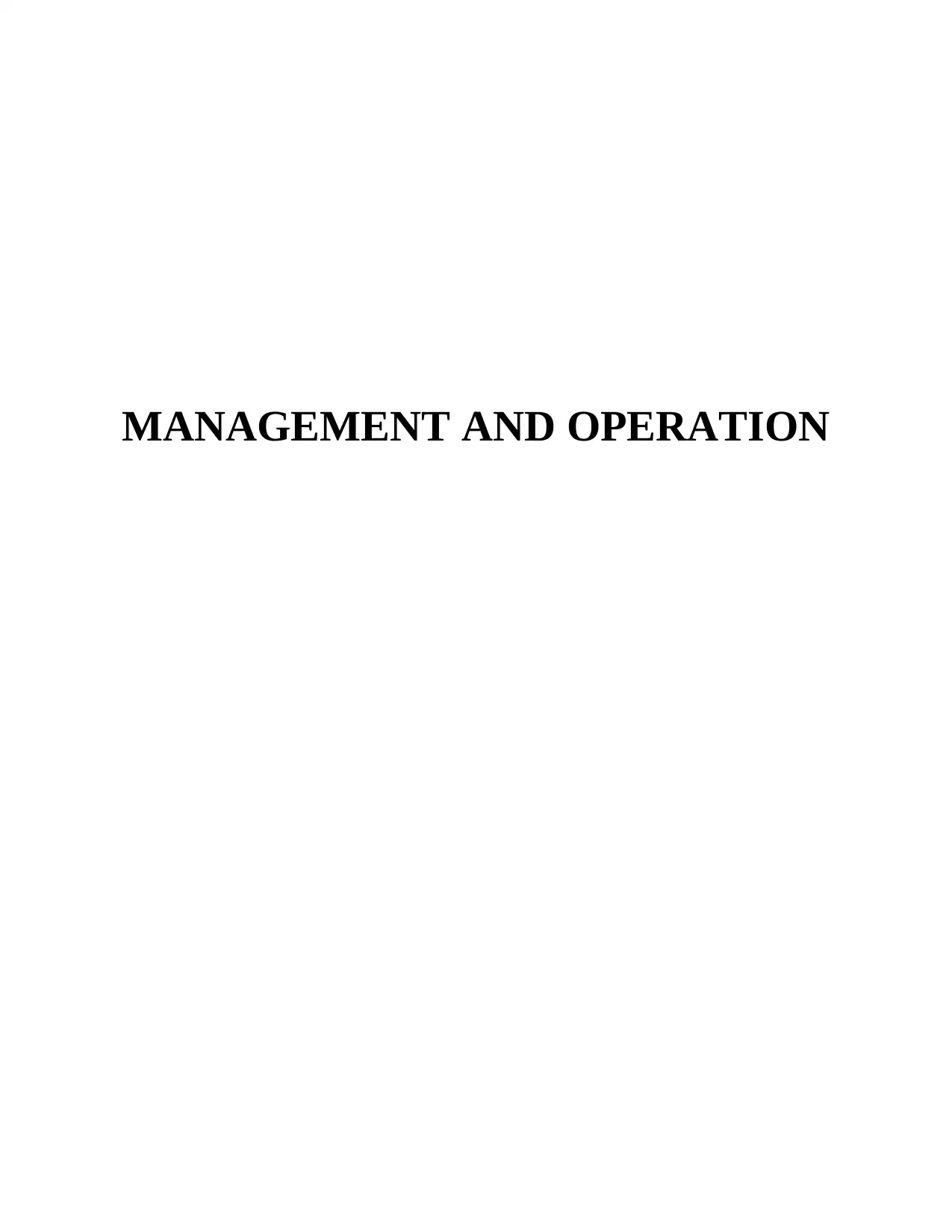
MANAGEMENT AND OPERATION
Paraphrase This Document
Need a fresh take? Get an instant paraphrase of this document with our AI Paraphraser
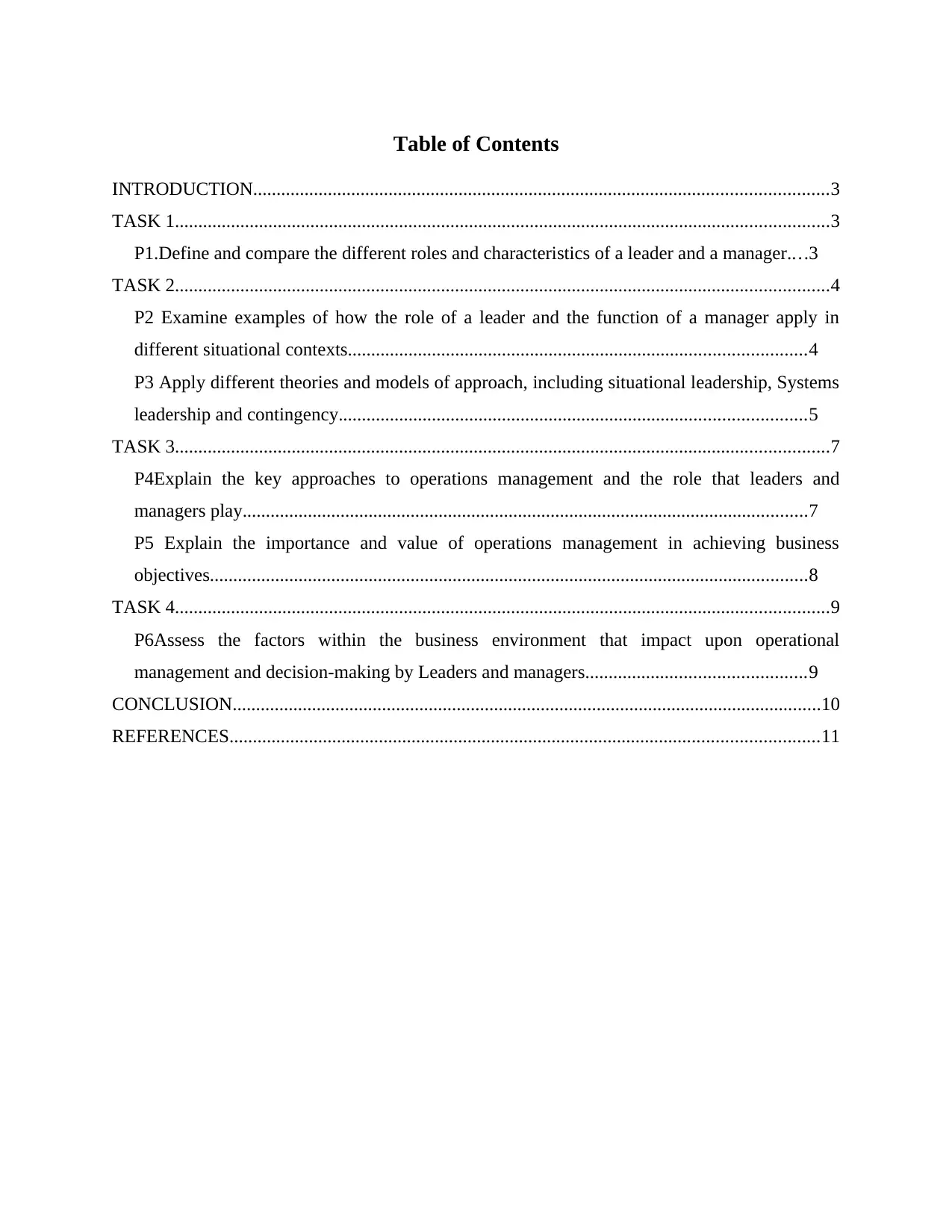
Table of Contents
INTRODUCTION...........................................................................................................................3
TASK 1............................................................................................................................................3
P1.Define and compare the different roles and characteristics of a leader and a manager....3
TASK 2............................................................................................................................................4
P2 Examine examples of how the role of a leader and the function of a manager apply in
different situational contexts..................................................................................................4
P3 Apply different theories and models of approach, including situational leadership, Systems
leadership and contingency....................................................................................................5
TASK 3............................................................................................................................................7
P4Explain the key approaches to operations management and the role that leaders and
managers play.........................................................................................................................7
P5 Explain the importance and value of operations management in achieving business
objectives................................................................................................................................8
TASK 4............................................................................................................................................9
P6Assess the factors within the business environment that impact upon operational
management and decision-making by Leaders and managers...............................................9
CONCLUSION..............................................................................................................................10
REFERENCES..............................................................................................................................11
INTRODUCTION...........................................................................................................................3
TASK 1............................................................................................................................................3
P1.Define and compare the different roles and characteristics of a leader and a manager....3
TASK 2............................................................................................................................................4
P2 Examine examples of how the role of a leader and the function of a manager apply in
different situational contexts..................................................................................................4
P3 Apply different theories and models of approach, including situational leadership, Systems
leadership and contingency....................................................................................................5
TASK 3............................................................................................................................................7
P4Explain the key approaches to operations management and the role that leaders and
managers play.........................................................................................................................7
P5 Explain the importance and value of operations management in achieving business
objectives................................................................................................................................8
TASK 4............................................................................................................................................9
P6Assess the factors within the business environment that impact upon operational
management and decision-making by Leaders and managers...............................................9
CONCLUSION..............................................................................................................................10
REFERENCES..............................................................................................................................11
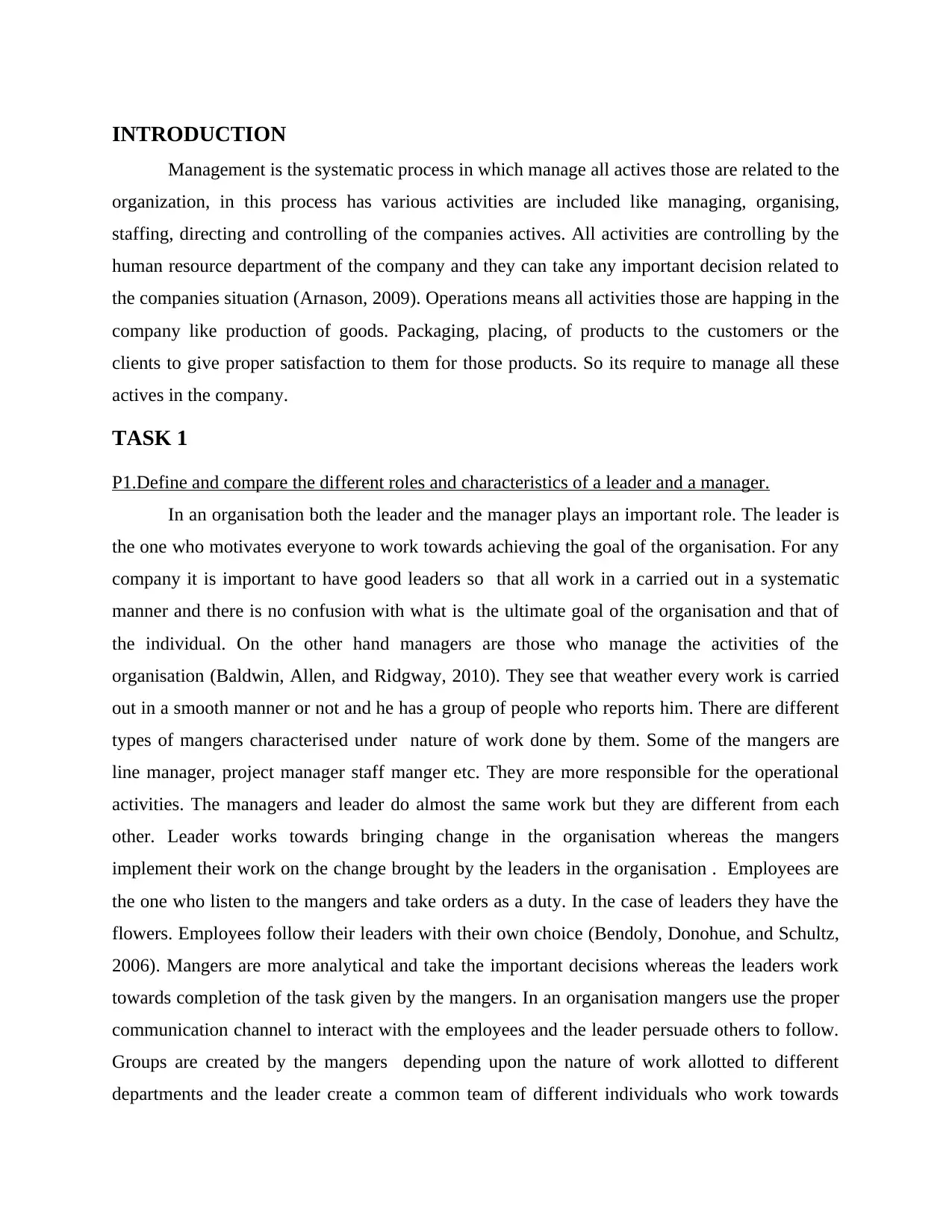
INTRODUCTION
Management is the systematic process in which manage all actives those are related to the
organization, in this process has various activities are included like managing, organising,
staffing, directing and controlling of the companies actives. All activities are controlling by the
human resource department of the company and they can take any important decision related to
the companies situation (Arnason, 2009). Operations means all activities those are happing in the
company like production of goods. Packaging, placing, of products to the customers or the
clients to give proper satisfaction to them for those products. So its require to manage all these
actives in the company.
TASK 1
P1.Define and compare the different roles and characteristics of a leader and a manager.
In an organisation both the leader and the manager plays an important role. The leader is
the one who motivates everyone to work towards achieving the goal of the organisation. For any
company it is important to have good leaders so that all work in a carried out in a systematic
manner and there is no confusion with what is the ultimate goal of the organisation and that of
the individual. On the other hand managers are those who manage the activities of the
organisation (Baldwin, Allen, and Ridgway, 2010). They see that weather every work is carried
out in a smooth manner or not and he has a group of people who reports him. There are different
types of mangers characterised under nature of work done by them. Some of the mangers are
line manager, project manager staff manger etc. They are more responsible for the operational
activities. The managers and leader do almost the same work but they are different from each
other. Leader works towards bringing change in the organisation whereas the mangers
implement their work on the change brought by the leaders in the organisation . Employees are
the one who listen to the mangers and take orders as a duty. In the case of leaders they have the
flowers. Employees follow their leaders with their own choice (Bendoly, Donohue, and Schultz,
2006). Mangers are more analytical and take the important decisions whereas the leaders work
towards completion of the task given by the mangers. In an organisation mangers use the proper
communication channel to interact with the employees and the leader persuade others to follow.
Groups are created by the mangers depending upon the nature of work allotted to different
departments and the leader create a common team of different individuals who work towards
Management is the systematic process in which manage all actives those are related to the
organization, in this process has various activities are included like managing, organising,
staffing, directing and controlling of the companies actives. All activities are controlling by the
human resource department of the company and they can take any important decision related to
the companies situation (Arnason, 2009). Operations means all activities those are happing in the
company like production of goods. Packaging, placing, of products to the customers or the
clients to give proper satisfaction to them for those products. So its require to manage all these
actives in the company.
TASK 1
P1.Define and compare the different roles and characteristics of a leader and a manager.
In an organisation both the leader and the manager plays an important role. The leader is
the one who motivates everyone to work towards achieving the goal of the organisation. For any
company it is important to have good leaders so that all work in a carried out in a systematic
manner and there is no confusion with what is the ultimate goal of the organisation and that of
the individual. On the other hand managers are those who manage the activities of the
organisation (Baldwin, Allen, and Ridgway, 2010). They see that weather every work is carried
out in a smooth manner or not and he has a group of people who reports him. There are different
types of mangers characterised under nature of work done by them. Some of the mangers are
line manager, project manager staff manger etc. They are more responsible for the operational
activities. The managers and leader do almost the same work but they are different from each
other. Leader works towards bringing change in the organisation whereas the mangers
implement their work on the change brought by the leaders in the organisation . Employees are
the one who listen to the mangers and take orders as a duty. In the case of leaders they have the
flowers. Employees follow their leaders with their own choice (Bendoly, Donohue, and Schultz,
2006). Mangers are more analytical and take the important decisions whereas the leaders work
towards completion of the task given by the mangers. In an organisation mangers use the proper
communication channel to interact with the employees and the leader persuade others to follow.
Groups are created by the mangers depending upon the nature of work allotted to different
departments and the leader create a common team of different individuals who work towards
⊘ This is a preview!⊘
Do you want full access?
Subscribe today to unlock all pages.

Trusted by 1+ million students worldwide
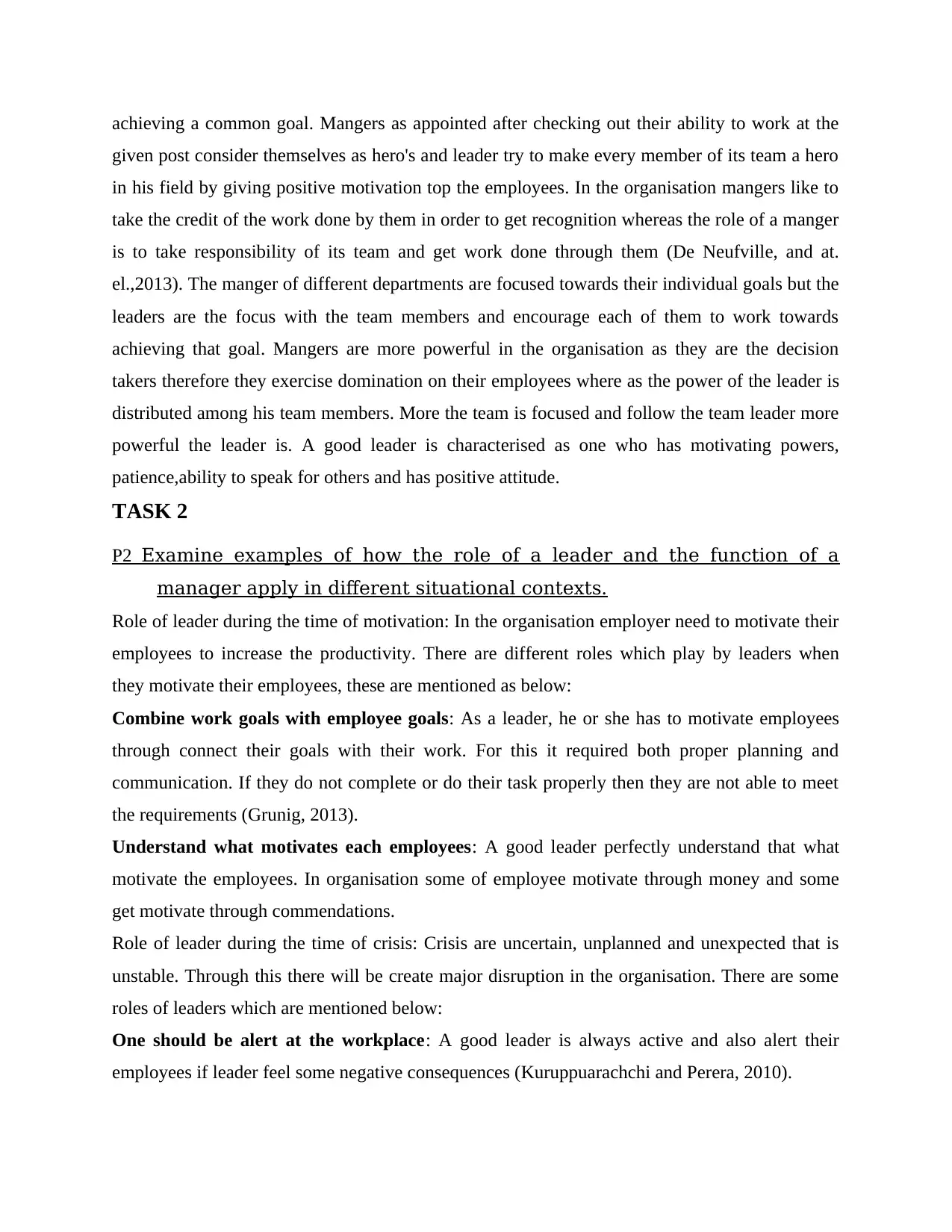
achieving a common goal. Mangers as appointed after checking out their ability to work at the
given post consider themselves as hero's and leader try to make every member of its team a hero
in his field by giving positive motivation top the employees. In the organisation mangers like to
take the credit of the work done by them in order to get recognition whereas the role of a manger
is to take responsibility of its team and get work done through them (De Neufville, and at.
el.,2013). The manger of different departments are focused towards their individual goals but the
leaders are the focus with the team members and encourage each of them to work towards
achieving that goal. Mangers are more powerful in the organisation as they are the decision
takers therefore they exercise domination on their employees where as the power of the leader is
distributed among his team members. More the team is focused and follow the team leader more
powerful the leader is. A good leader is characterised as one who has motivating powers,
patience,ability to speak for others and has positive attitude.
TASK 2
P2 Examine examples of how the role of a leader and the function of a
manager apply in different situational contexts.
Role of leader during the time of motivation: In the organisation employer need to motivate their
employees to increase the productivity. There are different roles which play by leaders when
they motivate their employees, these are mentioned as below:
Combine work goals with employee goals: As a leader, he or she has to motivate employees
through connect their goals with their work. For this it required both proper planning and
communication. If they do not complete or do their task properly then they are not able to meet
the requirements (Grunig, 2013).
Understand what motivates each employees: A good leader perfectly understand that what
motivate the employees. In organisation some of employee motivate through money and some
get motivate through commendations.
Role of leader during the time of crisis: Crisis are uncertain, unplanned and unexpected that is
unstable. Through this there will be create major disruption in the organisation. There are some
roles of leaders which are mentioned below:
One should be alert at the workplace: A good leader is always active and also alert their
employees if leader feel some negative consequences (Kuruppuarachchi and Perera, 2010).
given post consider themselves as hero's and leader try to make every member of its team a hero
in his field by giving positive motivation top the employees. In the organisation mangers like to
take the credit of the work done by them in order to get recognition whereas the role of a manger
is to take responsibility of its team and get work done through them (De Neufville, and at.
el.,2013). The manger of different departments are focused towards their individual goals but the
leaders are the focus with the team members and encourage each of them to work towards
achieving that goal. Mangers are more powerful in the organisation as they are the decision
takers therefore they exercise domination on their employees where as the power of the leader is
distributed among his team members. More the team is focused and follow the team leader more
powerful the leader is. A good leader is characterised as one who has motivating powers,
patience,ability to speak for others and has positive attitude.
TASK 2
P2 Examine examples of how the role of a leader and the function of a
manager apply in different situational contexts.
Role of leader during the time of motivation: In the organisation employer need to motivate their
employees to increase the productivity. There are different roles which play by leaders when
they motivate their employees, these are mentioned as below:
Combine work goals with employee goals: As a leader, he or she has to motivate employees
through connect their goals with their work. For this it required both proper planning and
communication. If they do not complete or do their task properly then they are not able to meet
the requirements (Grunig, 2013).
Understand what motivates each employees: A good leader perfectly understand that what
motivate the employees. In organisation some of employee motivate through money and some
get motivate through commendations.
Role of leader during the time of crisis: Crisis are uncertain, unplanned and unexpected that is
unstable. Through this there will be create major disruption in the organisation. There are some
roles of leaders which are mentioned below:
One should be alert at the workplace: A good leader is always active and also alert their
employees if leader feel some negative consequences (Kuruppuarachchi and Perera, 2010).
Paraphrase This Document
Need a fresh take? Get an instant paraphrase of this document with our AI Paraphraser
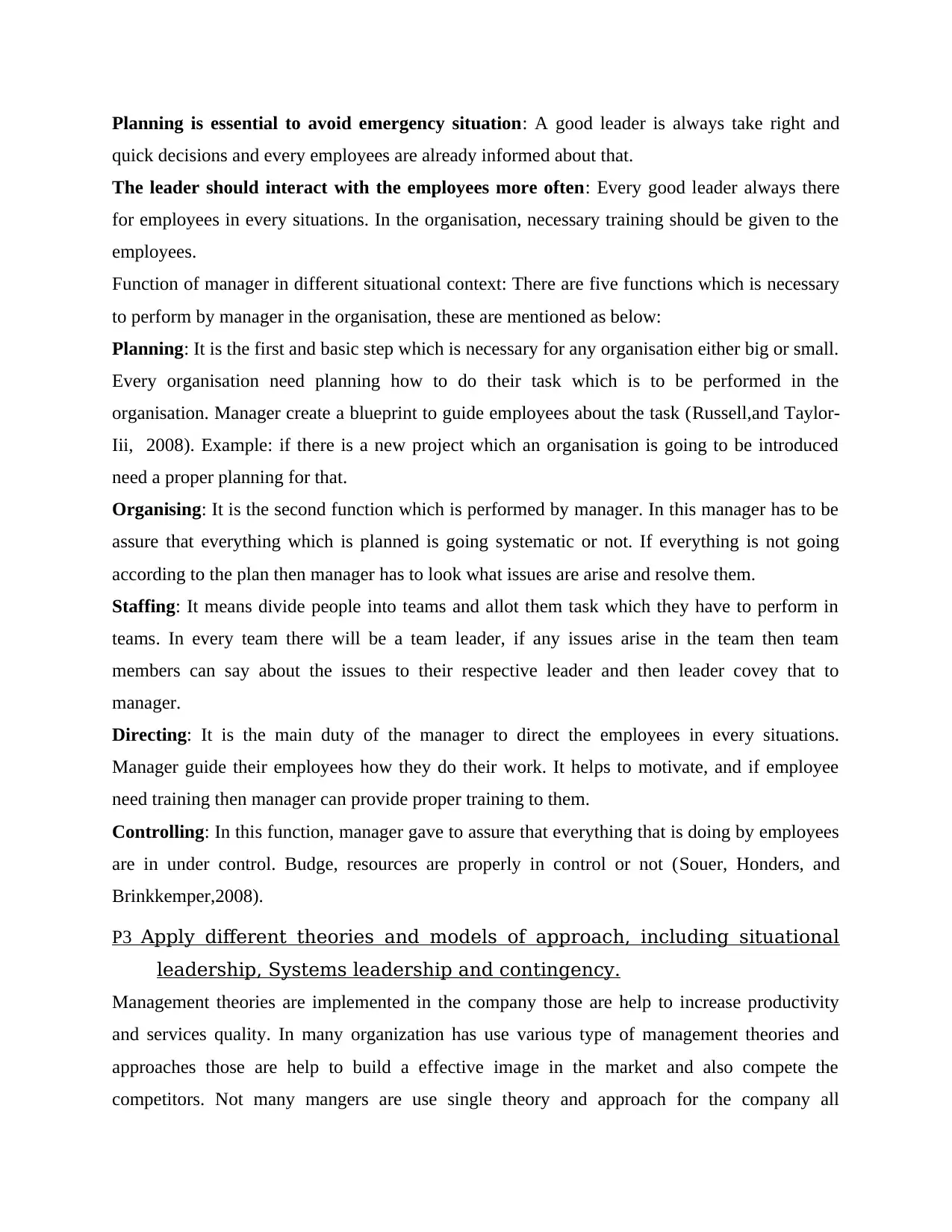
Planning is essential to avoid emergency situation: A good leader is always take right and
quick decisions and every employees are already informed about that.
The leader should interact with the employees more often: Every good leader always there
for employees in every situations. In the organisation, necessary training should be given to the
employees.
Function of manager in different situational context: There are five functions which is necessary
to perform by manager in the organisation, these are mentioned as below:
Planning: It is the first and basic step which is necessary for any organisation either big or small.
Every organisation need planning how to do their task which is to be performed in the
organisation. Manager create a blueprint to guide employees about the task (Russell,and Taylor-
Iii, 2008). Example: if there is a new project which an organisation is going to be introduced
need a proper planning for that.
Organising: It is the second function which is performed by manager. In this manager has to be
assure that everything which is planned is going systematic or not. If everything is not going
according to the plan then manager has to look what issues are arise and resolve them.
Staffing: It means divide people into teams and allot them task which they have to perform in
teams. In every team there will be a team leader, if any issues arise in the team then team
members can say about the issues to their respective leader and then leader covey that to
manager.
Directing: It is the main duty of the manager to direct the employees in every situations.
Manager guide their employees how they do their work. It helps to motivate, and if employee
need training then manager can provide proper training to them.
Controlling: In this function, manager gave to assure that everything that is doing by employees
are in under control. Budge, resources are properly in control or not (Souer, Honders, and
Brinkkemper,2008).
P3 Apply different theories and models of approach, including situational
leadership, Systems leadership and contingency.
Management theories are implemented in the company those are help to increase productivity
and services quality. In many organization has use various type of management theories and
approaches those are help to build a effective image in the market and also compete the
competitors. Not many mangers are use single theory and approach for the company all
quick decisions and every employees are already informed about that.
The leader should interact with the employees more often: Every good leader always there
for employees in every situations. In the organisation, necessary training should be given to the
employees.
Function of manager in different situational context: There are five functions which is necessary
to perform by manager in the organisation, these are mentioned as below:
Planning: It is the first and basic step which is necessary for any organisation either big or small.
Every organisation need planning how to do their task which is to be performed in the
organisation. Manager create a blueprint to guide employees about the task (Russell,and Taylor-
Iii, 2008). Example: if there is a new project which an organisation is going to be introduced
need a proper planning for that.
Organising: It is the second function which is performed by manager. In this manager has to be
assure that everything which is planned is going systematic or not. If everything is not going
according to the plan then manager has to look what issues are arise and resolve them.
Staffing: It means divide people into teams and allot them task which they have to perform in
teams. In every team there will be a team leader, if any issues arise in the team then team
members can say about the issues to their respective leader and then leader covey that to
manager.
Directing: It is the main duty of the manager to direct the employees in every situations.
Manager guide their employees how they do their work. It helps to motivate, and if employee
need training then manager can provide proper training to them.
Controlling: In this function, manager gave to assure that everything that is doing by employees
are in under control. Budge, resources are properly in control or not (Souer, Honders, and
Brinkkemper,2008).
P3 Apply different theories and models of approach, including situational
leadership, Systems leadership and contingency.
Management theories are implemented in the company those are help to increase productivity
and services quality. In many organization has use various type of management theories and
approaches those are help to build a effective image in the market and also compete the
competitors. Not many mangers are use single theory and approach for the company all
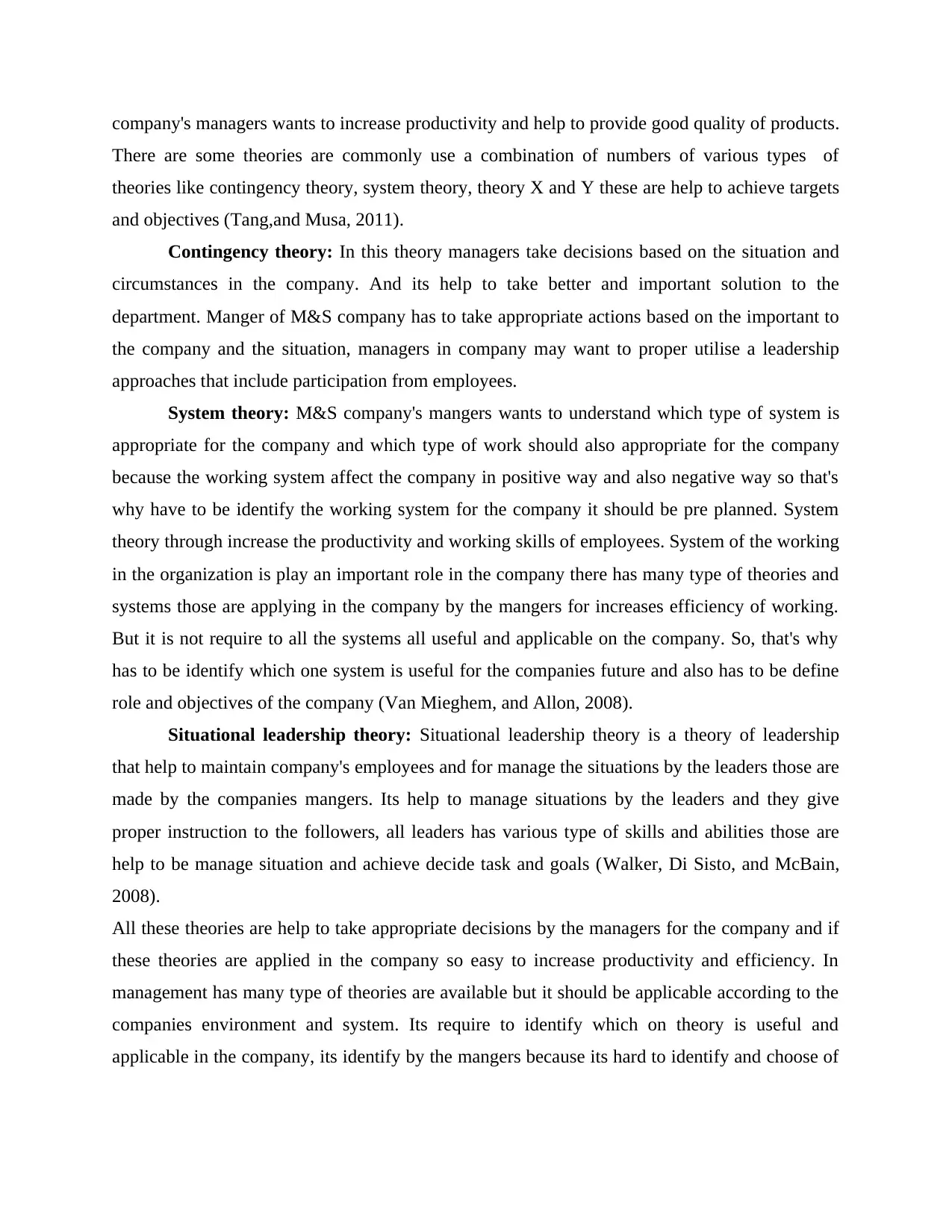
company's managers wants to increase productivity and help to provide good quality of products.
There are some theories are commonly use a combination of numbers of various types of
theories like contingency theory, system theory, theory X and Y these are help to achieve targets
and objectives (Tang,and Musa, 2011).
Contingency theory: In this theory managers take decisions based on the situation and
circumstances in the company. And its help to take better and important solution to the
department. Manger of M&S company has to take appropriate actions based on the important to
the company and the situation, managers in company may want to proper utilise a leadership
approaches that include participation from employees.
System theory: M&S company's mangers wants to understand which type of system is
appropriate for the company and which type of work should also appropriate for the company
because the working system affect the company in positive way and also negative way so that's
why have to be identify the working system for the company it should be pre planned. System
theory through increase the productivity and working skills of employees. System of the working
in the organization is play an important role in the company there has many type of theories and
systems those are applying in the company by the mangers for increases efficiency of working.
But it is not require to all the systems all useful and applicable on the company. So, that's why
has to be identify which one system is useful for the companies future and also has to be define
role and objectives of the company (Van Mieghem, and Allon, 2008).
Situational leadership theory: Situational leadership theory is a theory of leadership
that help to maintain company's employees and for manage the situations by the leaders those are
made by the companies mangers. Its help to manage situations by the leaders and they give
proper instruction to the followers, all leaders has various type of skills and abilities those are
help to be manage situation and achieve decide task and goals (Walker, Di Sisto, and McBain,
2008).
All these theories are help to take appropriate decisions by the managers for the company and if
these theories are applied in the company so easy to increase productivity and efficiency. In
management has many type of theories are available but it should be applicable according to the
companies environment and system. Its require to identify which on theory is useful and
applicable in the company, its identify by the mangers because its hard to identify and choose of
There are some theories are commonly use a combination of numbers of various types of
theories like contingency theory, system theory, theory X and Y these are help to achieve targets
and objectives (Tang,and Musa, 2011).
Contingency theory: In this theory managers take decisions based on the situation and
circumstances in the company. And its help to take better and important solution to the
department. Manger of M&S company has to take appropriate actions based on the important to
the company and the situation, managers in company may want to proper utilise a leadership
approaches that include participation from employees.
System theory: M&S company's mangers wants to understand which type of system is
appropriate for the company and which type of work should also appropriate for the company
because the working system affect the company in positive way and also negative way so that's
why have to be identify the working system for the company it should be pre planned. System
theory through increase the productivity and working skills of employees. System of the working
in the organization is play an important role in the company there has many type of theories and
systems those are applying in the company by the mangers for increases efficiency of working.
But it is not require to all the systems all useful and applicable on the company. So, that's why
has to be identify which one system is useful for the companies future and also has to be define
role and objectives of the company (Van Mieghem, and Allon, 2008).
Situational leadership theory: Situational leadership theory is a theory of leadership
that help to maintain company's employees and for manage the situations by the leaders those are
made by the companies mangers. Its help to manage situations by the leaders and they give
proper instruction to the followers, all leaders has various type of skills and abilities those are
help to be manage situation and achieve decide task and goals (Walker, Di Sisto, and McBain,
2008).
All these theories are help to take appropriate decisions by the managers for the company and if
these theories are applied in the company so easy to increase productivity and efficiency. In
management has many type of theories are available but it should be applicable according to the
companies environment and system. Its require to identify which on theory is useful and
applicable in the company, its identify by the mangers because its hard to identify and choose of
⊘ This is a preview!⊘
Do you want full access?
Subscribe today to unlock all pages.

Trusted by 1+ million students worldwide
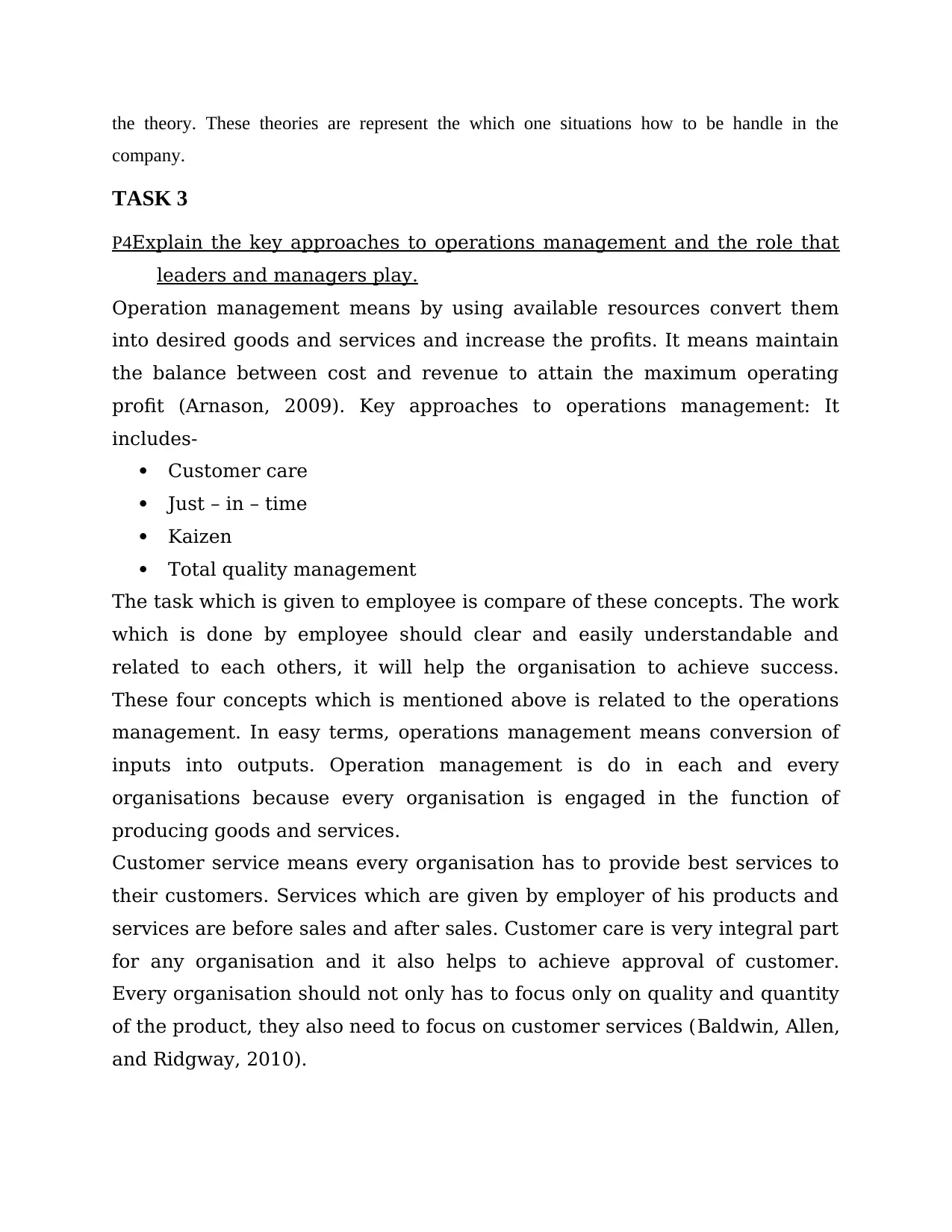
the theory. These theories are represent the which one situations how to be handle in the
company.
TASK 3
P4Explain the key approaches to operations management and the role that
leaders and managers play.
Operation management means by using available resources convert them
into desired goods and services and increase the profits. It means maintain
the balance between cost and revenue to attain the maximum operating
profit (Arnason, 2009). Key approaches to operations management: It
includes-
Customer care
Just – in – time
Kaizen
Total quality management
The task which is given to employee is compare of these concepts. The work
which is done by employee should clear and easily understandable and
related to each others, it will help the organisation to achieve success.
These four concepts which is mentioned above is related to the operations
management. In easy terms, operations management means conversion of
inputs into outputs. Operation management is do in each and every
organisations because every organisation is engaged in the function of
producing goods and services.
Customer service means every organisation has to provide best services to
their customers. Services which are given by employer of his products and
services are before sales and after sales. Customer care is very integral part
for any organisation and it also helps to achieve approval of customer.
Every organisation should not only has to focus only on quality and quantity
of the product, they also need to focus on customer services (Baldwin, Allen,
and Ridgway, 2010).
company.
TASK 3
P4Explain the key approaches to operations management and the role that
leaders and managers play.
Operation management means by using available resources convert them
into desired goods and services and increase the profits. It means maintain
the balance between cost and revenue to attain the maximum operating
profit (Arnason, 2009). Key approaches to operations management: It
includes-
Customer care
Just – in – time
Kaizen
Total quality management
The task which is given to employee is compare of these concepts. The work
which is done by employee should clear and easily understandable and
related to each others, it will help the organisation to achieve success.
These four concepts which is mentioned above is related to the operations
management. In easy terms, operations management means conversion of
inputs into outputs. Operation management is do in each and every
organisations because every organisation is engaged in the function of
producing goods and services.
Customer service means every organisation has to provide best services to
their customers. Services which are given by employer of his products and
services are before sales and after sales. Customer care is very integral part
for any organisation and it also helps to achieve approval of customer.
Every organisation should not only has to focus only on quality and quantity
of the product, they also need to focus on customer services (Baldwin, Allen,
and Ridgway, 2010).
Paraphrase This Document
Need a fresh take? Get an instant paraphrase of this document with our AI Paraphraser
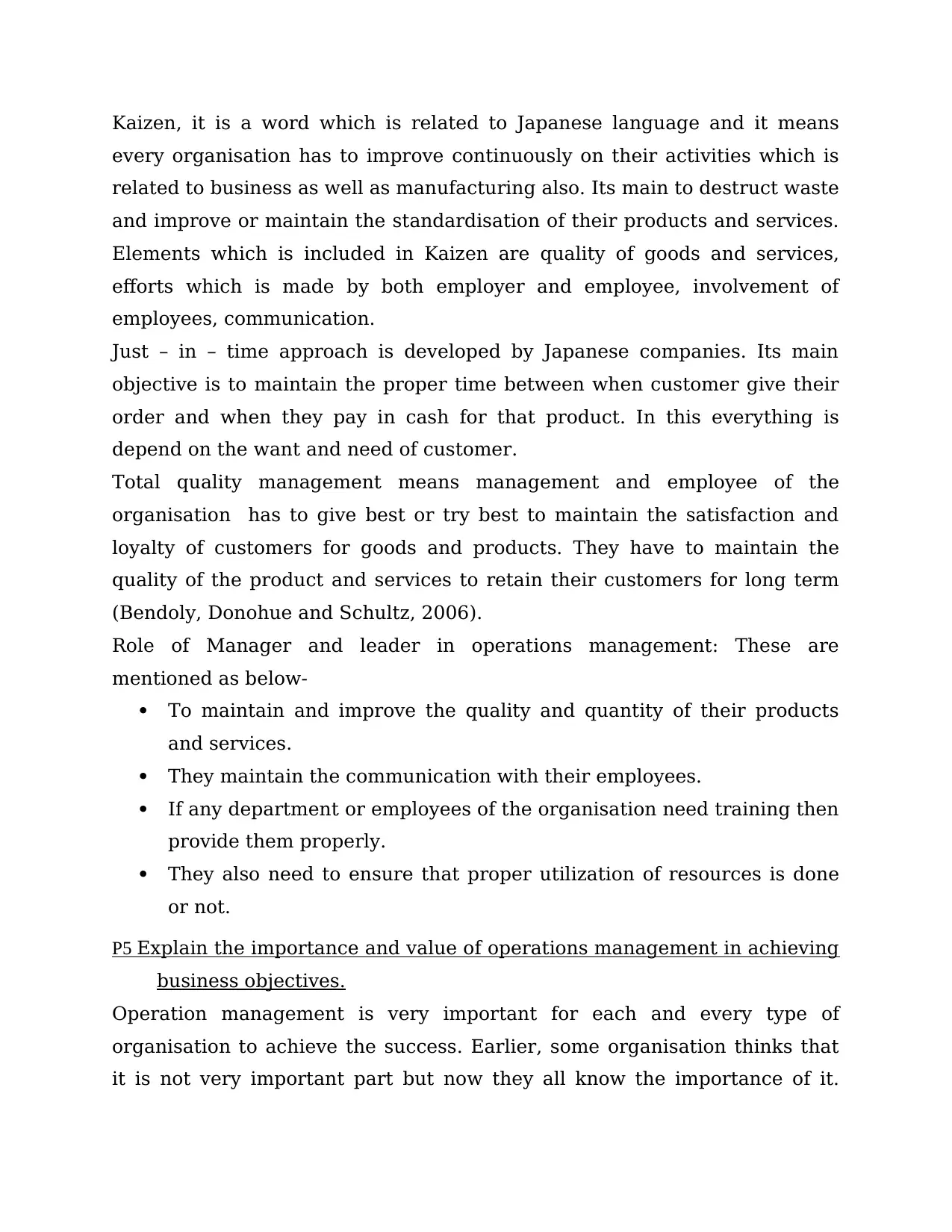
Kaizen, it is a word which is related to Japanese language and it means
every organisation has to improve continuously on their activities which is
related to business as well as manufacturing also. Its main to destruct waste
and improve or maintain the standardisation of their products and services.
Elements which is included in Kaizen are quality of goods and services,
efforts which is made by both employer and employee, involvement of
employees, communication.
Just – in – time approach is developed by Japanese companies. Its main
objective is to maintain the proper time between when customer give their
order and when they pay in cash for that product. In this everything is
depend on the want and need of customer.
Total quality management means management and employee of the
organisation has to give best or try best to maintain the satisfaction and
loyalty of customers for goods and products. They have to maintain the
quality of the product and services to retain their customers for long term
(Bendoly, Donohue and Schultz, 2006).
Role of Manager and leader in operations management: These are
mentioned as below-
To maintain and improve the quality and quantity of their products
and services.
They maintain the communication with their employees.
If any department or employees of the organisation need training then
provide them properly.
They also need to ensure that proper utilization of resources is done
or not.
P5 Explain the importance and value of operations management in achieving
business objectives.
Operation management is very important for each and every type of
organisation to achieve the success. Earlier, some organisation thinks that
it is not very important part but now they all know the importance of it.
every organisation has to improve continuously on their activities which is
related to business as well as manufacturing also. Its main to destruct waste
and improve or maintain the standardisation of their products and services.
Elements which is included in Kaizen are quality of goods and services,
efforts which is made by both employer and employee, involvement of
employees, communication.
Just – in – time approach is developed by Japanese companies. Its main
objective is to maintain the proper time between when customer give their
order and when they pay in cash for that product. In this everything is
depend on the want and need of customer.
Total quality management means management and employee of the
organisation has to give best or try best to maintain the satisfaction and
loyalty of customers for goods and products. They have to maintain the
quality of the product and services to retain their customers for long term
(Bendoly, Donohue and Schultz, 2006).
Role of Manager and leader in operations management: These are
mentioned as below-
To maintain and improve the quality and quantity of their products
and services.
They maintain the communication with their employees.
If any department or employees of the organisation need training then
provide them properly.
They also need to ensure that proper utilization of resources is done
or not.
P5 Explain the importance and value of operations management in achieving
business objectives.
Operation management is very important for each and every type of
organisation to achieve the success. Earlier, some organisation thinks that
it is not very important part but now they all know the importance of it.
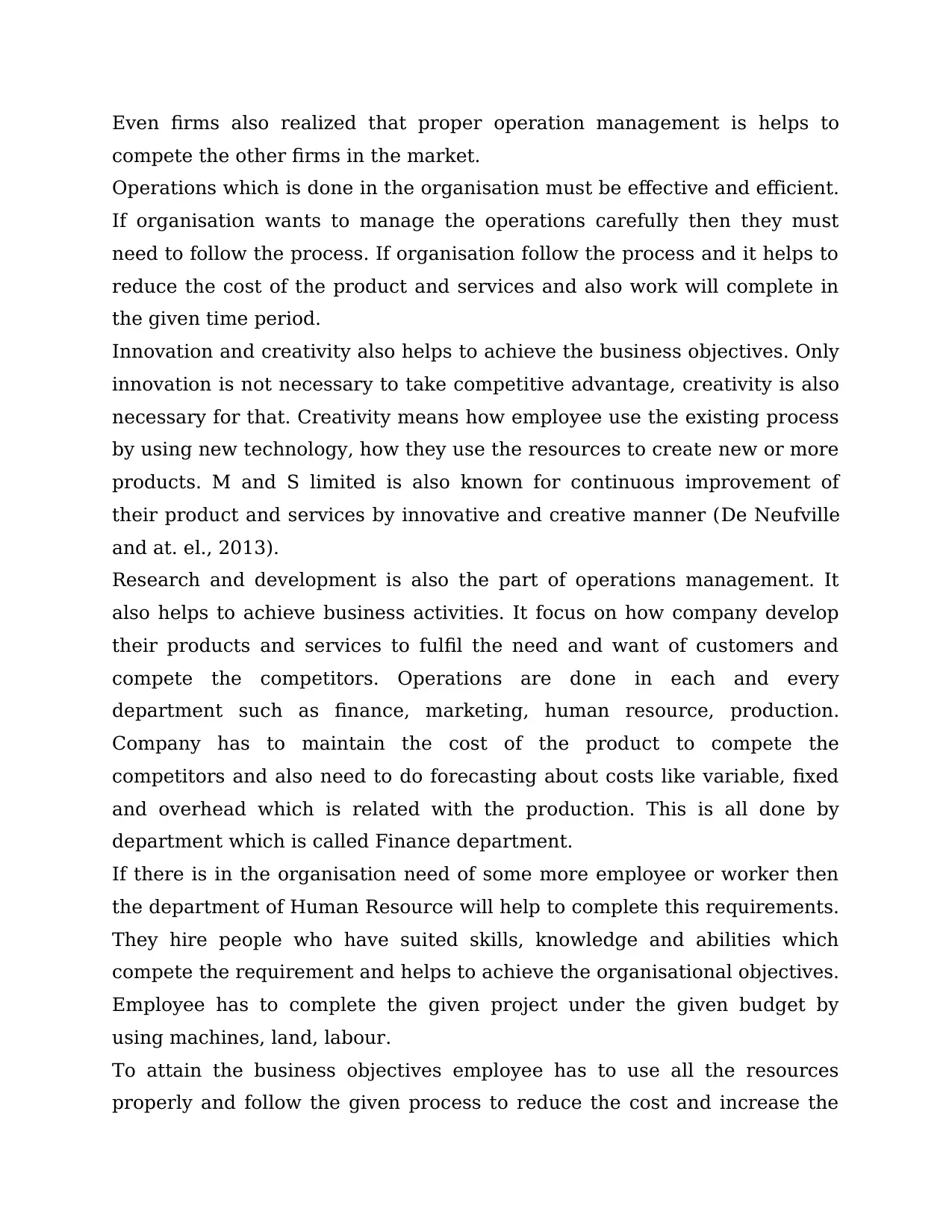
Even firms also realized that proper operation management is helps to
compete the other firms in the market.
Operations which is done in the organisation must be effective and efficient.
If organisation wants to manage the operations carefully then they must
need to follow the process. If organisation follow the process and it helps to
reduce the cost of the product and services and also work will complete in
the given time period.
Innovation and creativity also helps to achieve the business objectives. Only
innovation is not necessary to take competitive advantage, creativity is also
necessary for that. Creativity means how employee use the existing process
by using new technology, how they use the resources to create new or more
products. M and S limited is also known for continuous improvement of
their product and services by innovative and creative manner (De Neufville
and at. el., 2013).
Research and development is also the part of operations management. It
also helps to achieve business activities. It focus on how company develop
their products and services to fulfil the need and want of customers and
compete the competitors. Operations are done in each and every
department such as finance, marketing, human resource, production.
Company has to maintain the cost of the product to compete the
competitors and also need to do forecasting about costs like variable, fixed
and overhead which is related with the production. This is all done by
department which is called Finance department.
If there is in the organisation need of some more employee or worker then
the department of Human Resource will help to complete this requirements.
They hire people who have suited skills, knowledge and abilities which
compete the requirement and helps to achieve the organisational objectives.
Employee has to complete the given project under the given budget by
using machines, land, labour.
To attain the business objectives employee has to use all the resources
properly and follow the given process to reduce the cost and increase the
compete the other firms in the market.
Operations which is done in the organisation must be effective and efficient.
If organisation wants to manage the operations carefully then they must
need to follow the process. If organisation follow the process and it helps to
reduce the cost of the product and services and also work will complete in
the given time period.
Innovation and creativity also helps to achieve the business objectives. Only
innovation is not necessary to take competitive advantage, creativity is also
necessary for that. Creativity means how employee use the existing process
by using new technology, how they use the resources to create new or more
products. M and S limited is also known for continuous improvement of
their product and services by innovative and creative manner (De Neufville
and at. el., 2013).
Research and development is also the part of operations management. It
also helps to achieve business activities. It focus on how company develop
their products and services to fulfil the need and want of customers and
compete the competitors. Operations are done in each and every
department such as finance, marketing, human resource, production.
Company has to maintain the cost of the product to compete the
competitors and also need to do forecasting about costs like variable, fixed
and overhead which is related with the production. This is all done by
department which is called Finance department.
If there is in the organisation need of some more employee or worker then
the department of Human Resource will help to complete this requirements.
They hire people who have suited skills, knowledge and abilities which
compete the requirement and helps to achieve the organisational objectives.
Employee has to complete the given project under the given budget by
using machines, land, labour.
To attain the business objectives employee has to use all the resources
properly and follow the given process to reduce the cost and increase the
⊘ This is a preview!⊘
Do you want full access?
Subscribe today to unlock all pages.

Trusted by 1+ million students worldwide
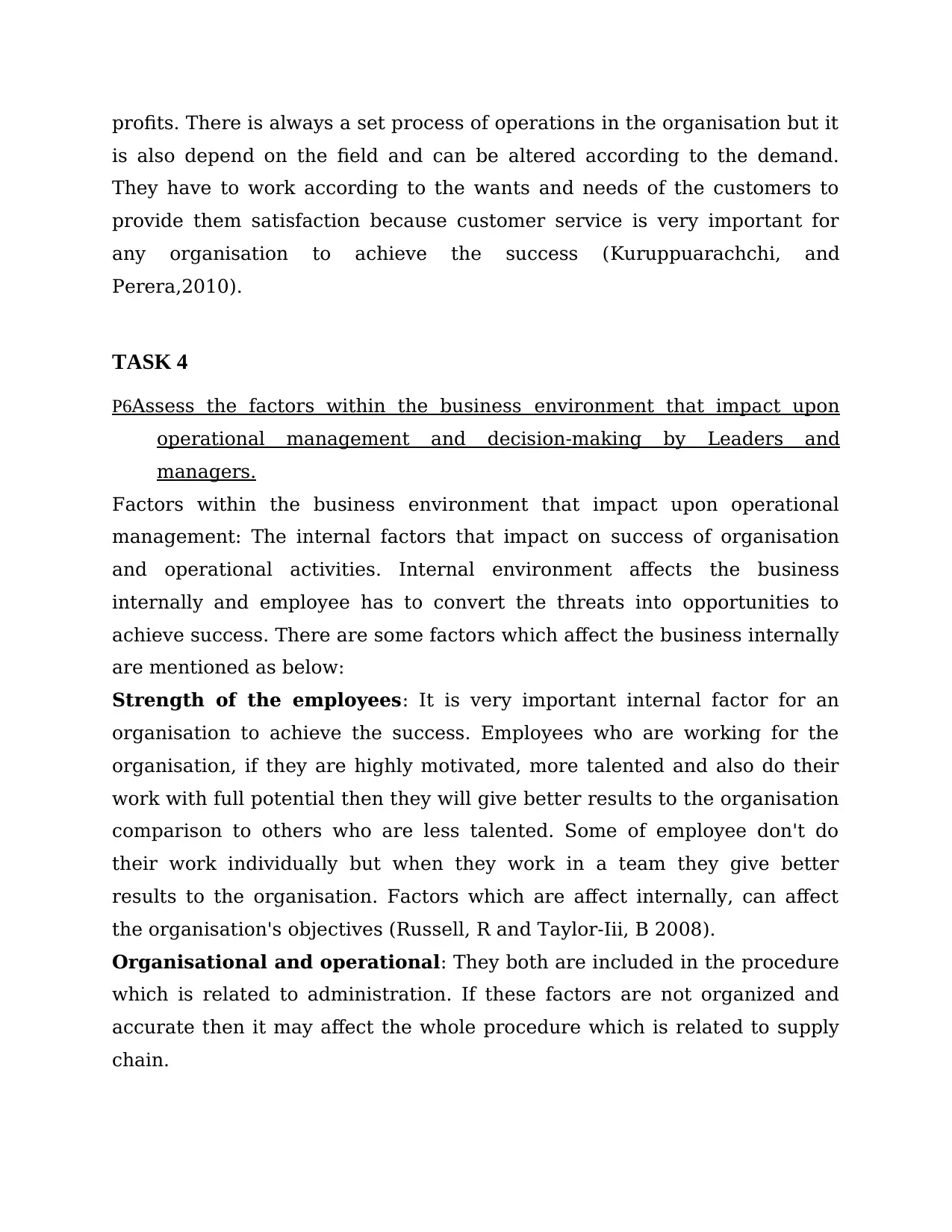
profits. There is always a set process of operations in the organisation but it
is also depend on the field and can be altered according to the demand.
They have to work according to the wants and needs of the customers to
provide them satisfaction because customer service is very important for
any organisation to achieve the success (Kuruppuarachchi, and
Perera,2010).
TASK 4
P6Assess the factors within the business environment that impact upon
operational management and decision-making by Leaders and
managers.
Factors within the business environment that impact upon operational
management: The internal factors that impact on success of organisation
and operational activities. Internal environment affects the business
internally and employee has to convert the threats into opportunities to
achieve success. There are some factors which affect the business internally
are mentioned as below:
Strength of the employees: It is very important internal factor for an
organisation to achieve the success. Employees who are working for the
organisation, if they are highly motivated, more talented and also do their
work with full potential then they will give better results to the organisation
comparison to others who are less talented. Some of employee don't do
their work individually but when they work in a team they give better
results to the organisation. Factors which are affect internally, can affect
the organisation's objectives (Russell, R and Taylor-Iii, B 2008).
Organisational and operational: They both are included in the procedure
which is related to administration. If these factors are not organized and
accurate then it may affect the whole procedure which is related to supply
chain.
is also depend on the field and can be altered according to the demand.
They have to work according to the wants and needs of the customers to
provide them satisfaction because customer service is very important for
any organisation to achieve the success (Kuruppuarachchi, and
Perera,2010).
TASK 4
P6Assess the factors within the business environment that impact upon
operational management and decision-making by Leaders and
managers.
Factors within the business environment that impact upon operational
management: The internal factors that impact on success of organisation
and operational activities. Internal environment affects the business
internally and employee has to convert the threats into opportunities to
achieve success. There are some factors which affect the business internally
are mentioned as below:
Strength of the employees: It is very important internal factor for an
organisation to achieve the success. Employees who are working for the
organisation, if they are highly motivated, more talented and also do their
work with full potential then they will give better results to the organisation
comparison to others who are less talented. Some of employee don't do
their work individually but when they work in a team they give better
results to the organisation. Factors which are affect internally, can affect
the organisation's objectives (Russell, R and Taylor-Iii, B 2008).
Organisational and operational: They both are included in the procedure
which is related to administration. If these factors are not organized and
accurate then it may affect the whole procedure which is related to supply
chain.
Paraphrase This Document
Need a fresh take? Get an instant paraphrase of this document with our AI Paraphraser
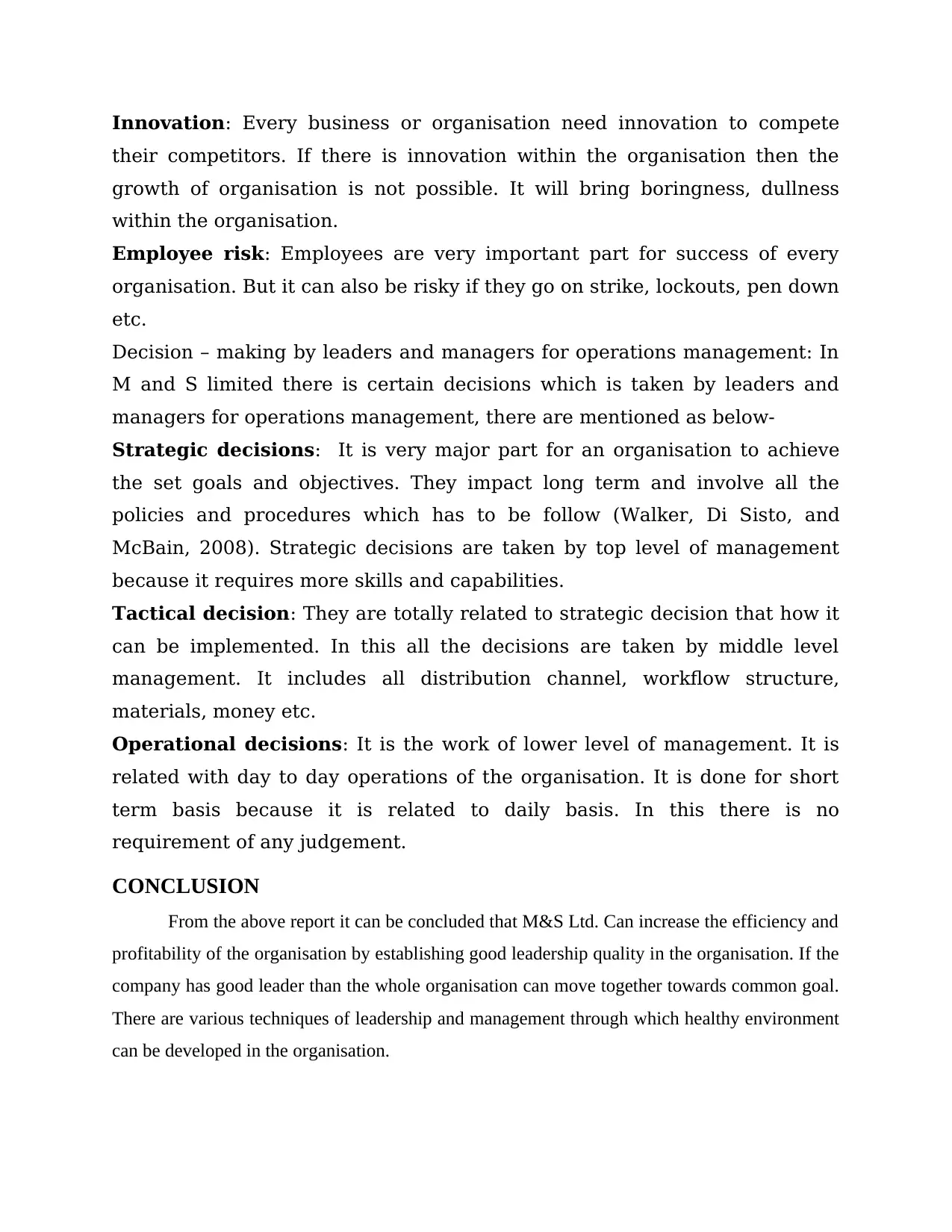
Innovation: Every business or organisation need innovation to compete
their competitors. If there is innovation within the organisation then the
growth of organisation is not possible. It will bring boringness, dullness
within the organisation.
Employee risk: Employees are very important part for success of every
organisation. But it can also be risky if they go on strike, lockouts, pen down
etc.
Decision – making by leaders and managers for operations management: In
M and S limited there is certain decisions which is taken by leaders and
managers for operations management, there are mentioned as below-
Strategic decisions: It is very major part for an organisation to achieve
the set goals and objectives. They impact long term and involve all the
policies and procedures which has to be follow (Walker, Di Sisto, and
McBain, 2008). Strategic decisions are taken by top level of management
because it requires more skills and capabilities.
Tactical decision: They are totally related to strategic decision that how it
can be implemented. In this all the decisions are taken by middle level
management. It includes all distribution channel, workflow structure,
materials, money etc.
Operational decisions: It is the work of lower level of management. It is
related with day to day operations of the organisation. It is done for short
term basis because it is related to daily basis. In this there is no
requirement of any judgement.
CONCLUSION
From the above report it can be concluded that M&S Ltd. Can increase the efficiency and
profitability of the organisation by establishing good leadership quality in the organisation. If the
company has good leader than the whole organisation can move together towards common goal.
There are various techniques of leadership and management through which healthy environment
can be developed in the organisation.
their competitors. If there is innovation within the organisation then the
growth of organisation is not possible. It will bring boringness, dullness
within the organisation.
Employee risk: Employees are very important part for success of every
organisation. But it can also be risky if they go on strike, lockouts, pen down
etc.
Decision – making by leaders and managers for operations management: In
M and S limited there is certain decisions which is taken by leaders and
managers for operations management, there are mentioned as below-
Strategic decisions: It is very major part for an organisation to achieve
the set goals and objectives. They impact long term and involve all the
policies and procedures which has to be follow (Walker, Di Sisto, and
McBain, 2008). Strategic decisions are taken by top level of management
because it requires more skills and capabilities.
Tactical decision: They are totally related to strategic decision that how it
can be implemented. In this all the decisions are taken by middle level
management. It includes all distribution channel, workflow structure,
materials, money etc.
Operational decisions: It is the work of lower level of management. It is
related with day to day operations of the organisation. It is done for short
term basis because it is related to daily basis. In this there is no
requirement of any judgement.
CONCLUSION
From the above report it can be concluded that M&S Ltd. Can increase the efficiency and
profitability of the organisation by establishing good leadership quality in the organisation. If the
company has good leader than the whole organisation can move together towards common goal.
There are various techniques of leadership and management through which healthy environment
can be developed in the organisation.
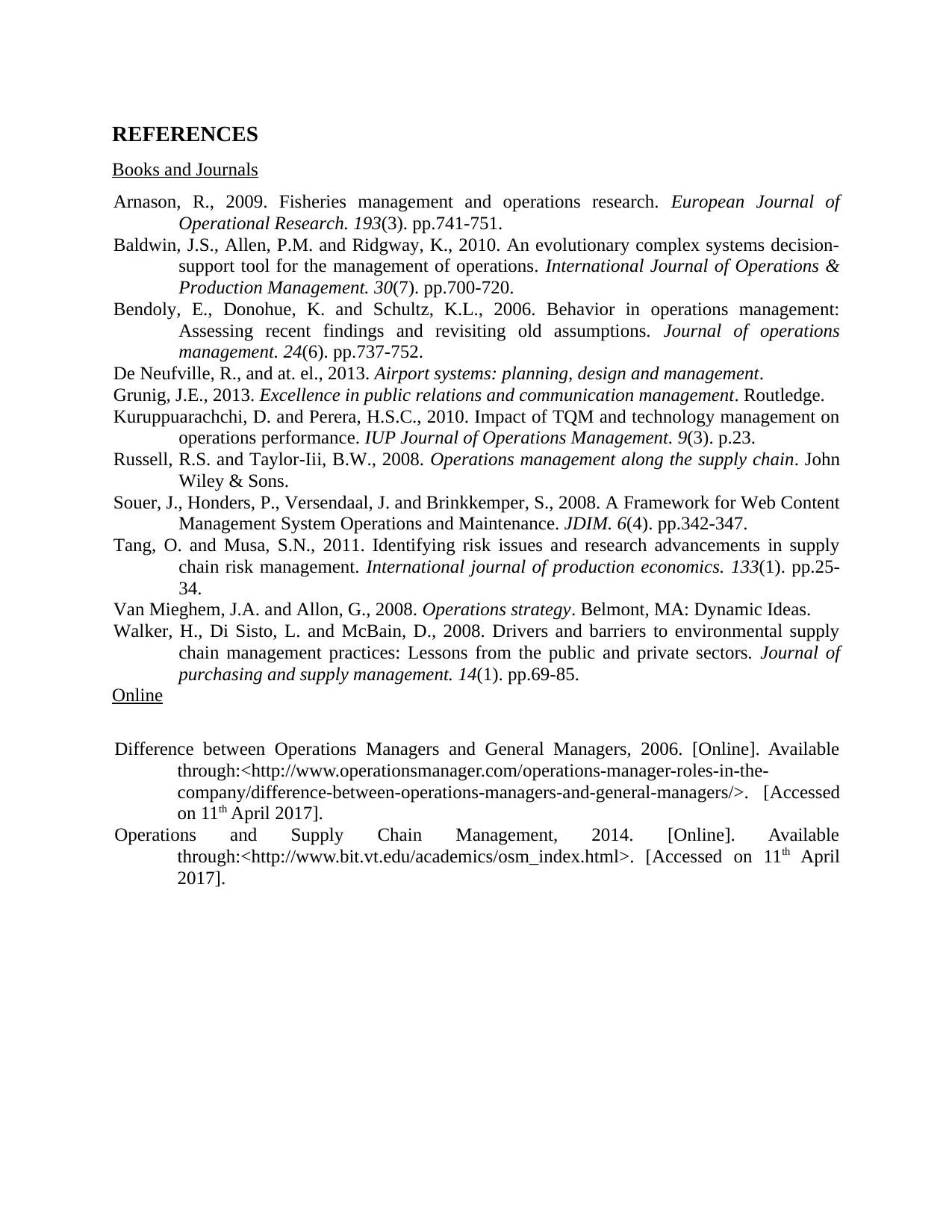
REFERENCES
Books and Journals
Arnason, R., 2009. Fisheries management and operations research. European Journal of
Operational Research. 193(3). pp.741-751.
Baldwin, J.S., Allen, P.M. and Ridgway, K., 2010. An evolutionary complex systems decision-
support tool for the management of operations. International Journal of Operations &
Production Management. 30(7). pp.700-720.
Bendoly, E., Donohue, K. and Schultz, K.L., 2006. Behavior in operations management:
Assessing recent findings and revisiting old assumptions. Journal of operations
management. 24(6). pp.737-752.
De Neufville, R., and at. el., 2013. Airport systems: planning, design and management.
Grunig, J.E., 2013. Excellence in public relations and communication management. Routledge.
Kuruppuarachchi, D. and Perera, H.S.C., 2010. Impact of TQM and technology management on
operations performance. IUP Journal of Operations Management. 9(3). p.23.
Russell, R.S. and Taylor-Iii, B.W., 2008. Operations management along the supply chain. John
Wiley & Sons.
Souer, J., Honders, P., Versendaal, J. and Brinkkemper, S., 2008. A Framework for Web Content
Management System Operations and Maintenance. JDIM. 6(4). pp.342-347.
Tang, O. and Musa, S.N., 2011. Identifying risk issues and research advancements in supply
chain risk management. International journal of production economics. 133(1). pp.25-
34.
Van Mieghem, J.A. and Allon, G., 2008. Operations strategy. Belmont, MA: Dynamic Ideas.
Walker, H., Di Sisto, L. and McBain, D., 2008. Drivers and barriers to environmental supply
chain management practices: Lessons from the public and private sectors. Journal of
purchasing and supply management. 14(1). pp.69-85.
Online
Difference between Operations Managers and General Managers, 2006. [Online]. Available
through:<http://www.operationsmanager.com/operations-manager-roles-in-the-
company/difference-between-operations-managers-and-general-managers/>. [Accessed
on 11th April 2017].
Operations and Supply Chain Management, 2014. [Online]. Available
through:<http://www.bit.vt.edu/academics/osm_index.html>. [Accessed on 11th April
2017].
Books and Journals
Arnason, R., 2009. Fisheries management and operations research. European Journal of
Operational Research. 193(3). pp.741-751.
Baldwin, J.S., Allen, P.M. and Ridgway, K., 2010. An evolutionary complex systems decision-
support tool for the management of operations. International Journal of Operations &
Production Management. 30(7). pp.700-720.
Bendoly, E., Donohue, K. and Schultz, K.L., 2006. Behavior in operations management:
Assessing recent findings and revisiting old assumptions. Journal of operations
management. 24(6). pp.737-752.
De Neufville, R., and at. el., 2013. Airport systems: planning, design and management.
Grunig, J.E., 2013. Excellence in public relations and communication management. Routledge.
Kuruppuarachchi, D. and Perera, H.S.C., 2010. Impact of TQM and technology management on
operations performance. IUP Journal of Operations Management. 9(3). p.23.
Russell, R.S. and Taylor-Iii, B.W., 2008. Operations management along the supply chain. John
Wiley & Sons.
Souer, J., Honders, P., Versendaal, J. and Brinkkemper, S., 2008. A Framework for Web Content
Management System Operations and Maintenance. JDIM. 6(4). pp.342-347.
Tang, O. and Musa, S.N., 2011. Identifying risk issues and research advancements in supply
chain risk management. International journal of production economics. 133(1). pp.25-
34.
Van Mieghem, J.A. and Allon, G., 2008. Operations strategy. Belmont, MA: Dynamic Ideas.
Walker, H., Di Sisto, L. and McBain, D., 2008. Drivers and barriers to environmental supply
chain management practices: Lessons from the public and private sectors. Journal of
purchasing and supply management. 14(1). pp.69-85.
Online
Difference between Operations Managers and General Managers, 2006. [Online]. Available
through:<http://www.operationsmanager.com/operations-manager-roles-in-the-
company/difference-between-operations-managers-and-general-managers/>. [Accessed
on 11th April 2017].
Operations and Supply Chain Management, 2014. [Online]. Available
through:<http://www.bit.vt.edu/academics/osm_index.html>. [Accessed on 11th April
2017].
⊘ This is a preview!⊘
Do you want full access?
Subscribe today to unlock all pages.

Trusted by 1+ million students worldwide
1 out of 12
Related Documents
Your All-in-One AI-Powered Toolkit for Academic Success.
+13062052269
info@desklib.com
Available 24*7 on WhatsApp / Email
![[object Object]](/_next/static/media/star-bottom.7253800d.svg)
Unlock your academic potential
Copyright © 2020–2025 A2Z Services. All Rights Reserved. Developed and managed by ZUCOL.





